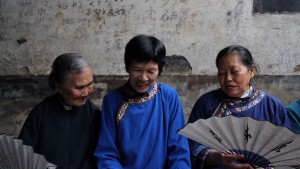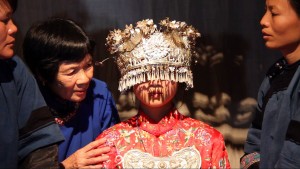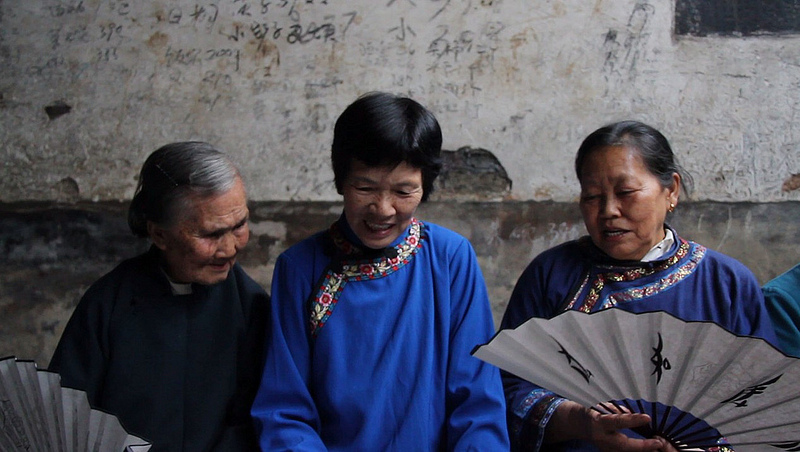Understanding Nu Shu

Ever since starting work on the Endangered Alphabets five years ago, I’ve been fascinated by the complicated and often mysterious relationship between a language (written or spoken) and the culture that developed it. But I’ve never had such a potent, vivid and moving illustration of that relationship as I had by watching the Philadelphia Orchestra perform Tan Dun’s “Nu Shu: The Secret Songs of Women” at the Saratoga Performing Arts Center last night.
First, a quick recap of the facts as I knew them before the concert. Nu Shu is–or perhaps was, as the last native speaker died a decade ago—an ancient language created by women in Hunan province, a language whose existence was unknown to outsiders until the late 20th century. As women were forbidden an education, they created their own script, passing it down secretly from mother to daughter.
That rather academic synopsis gives no clue about the real questions, though. Who were these people? What must their life have been like, to need a secret language? And what do you say or write that you can only say in secret?
Tan Dun, who scored the movie Crouching Tiger, Hidden Dragon, went back to a remote village in his native province of Hunan, recorded over 200 hours of audio and video, and created a multi-media work for orchestra, recorded voices and projected images.
The work consisted of thirteen movements: Secret Fan; Mother’s Song; Dressing for the Wedding; Cry-Singing fo Marriage; Nu Shu Village; Longing for Her Sister; A Road Without End; Forever Sisters; Daughter’s River; Grandma’s Echo; The Book of Tears; Soul Bridge; and Living in the Dream.
The featured soloist was harpist Elizabeth Hainen, who had the sculpted arms of a pole vaulter; the instrumentation was predominantly strings, flute, oboe, and percussion, with additional handmade sound effects: water trickling into a bowl, the string players’ bows rapping on their instruments to imitate the snapping of fans.
In case this all sounds a little gimmicky, let me set you straight: the effect was so powerful it not only left me (and others) devastated, it changed my entire understanding of Nu Shu, or Nushu.
The music was by turns dramatic, plaintive, reflective, melancholy and grief-stricken, but it was the video images of the (mostly elderly) women singing in Nu Shu and the circumstances of their singing that changed everything.

“Dressing for the Wedding,” for example, sounds joyful until it becomes clear that the wedding would have been arranged, the daughter no more then fifteen, and the wedding itself might be the last time the mother and daughter might ever see each other.
Nowhere was this unsettling combination of celebration and grief more evident than in the fourth movement, “Cry-Singing for Marriage.” In this culture the wedding tradition, according to Tan Dun’s program notes, features three days of constant crying, stylized into song. The resulting tear-soaked scarf serves as a link between mother and daughter.
I, for one, was glad that this was followed by the cheerfulness-in-daily-life humor of “Nu Shu Village,” but the real meaning of Nu Shu was already clear: it was developed to express emotions that were inconvenient or even unacceptable to the orderly regulation of human life, and as such these songs represent an entire panorama of repressed emotion. Mothers losing daughters, daughters losing mothers, sisters losing each other—a social web so torn, so desperate it needs a secret language, a language to bear such emotional weight.
The apparently tranquil, even transcendent “Soul Bridge,” which shows a young woman walking thoughtfully across an ornate bridge, has a sadder undercurrent: this is a bridge where she walks to remember her mother, who may be dead or simply not seen for decades.
The final movement, celebrating the working community of women, seemed just a little too obviously a happy ending. These songs, these written words, joined women, to be sure, and I hope to be able to carve more Nu Shu proverbs and words of encouragement—but they were needed because those women were routinely separated, sundered, left devastated and in despair.


August 16, 2014 @ 6:56 pm
I so enjoyed your post, which led me to catch a glimpse (auditory and visual) of what you experienced last night, here.. http://www.classicalite.com/articles/2534/20130829/nu-shu-chinas-secret-language-women-speaks-out-tan-dun.htm
It all reminds me of a book I read years ago – Wild Swans, by Jung Chang, which reveals the plight of 3 generations of Chinese women in the 20’th century.
Nu Shu is a wonderful extention to the Endangered Alphabets project.
-Elizabeth
August 19, 2014 @ 3:15 pm
Hi Tim,
I have been relishing that evening with my “sisters” and enjoyed reading your blog about the performance. Even though the despair was so evident, there was a ray of hope, I thought…it seemed that one of the movements portrayed the passing of the song/language from an older voice to a younger one.
>
> The Mahler piece that followed was beautifully done, but for me sounded almost frivolous after the amazing sounds of Tan Dun’s composition. Along with the Nu Shu voices, I loved the live sound effects too (and could imagine myself being able to play the water or the rocks in the orchestra.)
Best,
Dede
June 5, 2019 @ 4:42 am
I had never heard or heard of, the words by shu until, a few days ago when I happened upon Snow Flower and the Secret Fan, a novel by Lisa See.
I read the fly leaf on the inside cover and was so interested that I began looking for information and those two words have led me to this page.
No, I haven’t begun to read the novel yet, but i begin it tonight.
Thank you for sharing so much with me; I am anxious now to open the cover and start my nu shu journey.